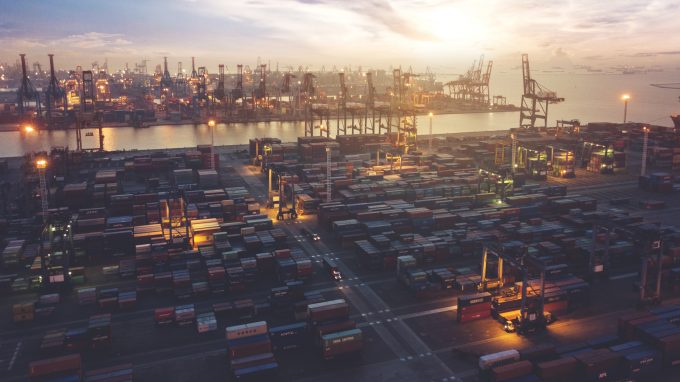Hamburg Port's Jens Meier elected new president of IAPH
Hamburg Port Authority CEO Jens Meier (above) has been elected as the new president of ...
GM: RAISING THE ROOF GGM: IN FULL THROTTLE GZIM: MAERSK BOOST KNIN: READ-ACROSSMAERSK: NOT ENOUGHMAERSK: GUIDANCE UPGRADEZIM: ROLLERCOASTERCAT: HEAVY DUTYMAERSK: CATCHING UP PG: DESTOCKING PATTERNSPG: HEALTH CHECKWTC: THE FALLGXO: DEFENSIVE FWRD: RALLYING ON TAKEOVER TALKODFL: STEADY YIELDVW: NEW MODEL NEEDEDWTC: TAKING PROFIT
GM: RAISING THE ROOF GGM: IN FULL THROTTLE GZIM: MAERSK BOOST KNIN: READ-ACROSSMAERSK: NOT ENOUGHMAERSK: GUIDANCE UPGRADEZIM: ROLLERCOASTERCAT: HEAVY DUTYMAERSK: CATCHING UP PG: DESTOCKING PATTERNSPG: HEALTH CHECKWTC: THE FALLGXO: DEFENSIVE FWRD: RALLYING ON TAKEOVER TALKODFL: STEADY YIELDVW: NEW MODEL NEEDEDWTC: TAKING PROFIT

It has taken a major global crisis to drive home just how important ports are to modern supply chains.
Congestion at US ports has spread like wildfire across the globe, acting as a brake on cargo velocity and as an effective vessel capacity cap.
Given the importance of ports as a funnel for trade, and the critical role they play in the supply chain – from distributing goods to value-added services at logistics centres – it is critical to modernise these gateways, smoothing the flow of freight and reducing supply chain friction.
Seaports today have already undergone substantial change, moving from being a simple gateway to seaborne transport and inland waterways supporting local industries to becoming arenas of business activity.
In support of their traditional roles as gateways, ports now have the possibility to be digital, energy and information nodes – and to do it all in a sustainable manner – empowered by digitalisation and the sharing of relevant information via data streams.
A key question then becomes how do the ports arrange their digital infrastructures to provide the expected or targeted beneficial outcomes?
Different ports are at different starting positions and will want to adopt different degrees of digitalisation. At many smaller ports, much of the information is not managed digitally. Some have taken pioneering steps to become first-movers in the adoption of advanced technologies for collaboration, synchronisation, automation and analytics. But, for most, digitalisation skills are only a small part of their capability set and few smaller and medium-sized ports can run larger digitalisation projects themselves.
However, there is movement towards companies providing simplified and less-complex solutions for specific-use cases. Ports can also pool together and share development costs.
Based on the experiences of Swedish ports, a digital three-step maturity model has been developed that accommodates the different situations for individual ports. The maturity model takes a formal digitalisation strategy as the basis for informing actions on subsequent steps.
The first step is achieved with digitally connected infrastructure, and the second is the achievement of digital collaboration (both between the port actors as well as becoming established as a communication party to the outside world). The final step is to have in place defined services and business models for digital business activity.

Maturity model for developing port digital maturity (illustration: Sandra Haraldson)
The digital maturity model allows a port to adopt a gradual approach to developing its digital maturity. The model takes the port’s digital strategy as the point of departure and then pinpoints different use cases and digital services on the three levels of maturity: connected infrastructure (level 1); digital collaboration (level 2); and servicification and business opportunities (level 3).
Only 20% of the 4,900 ports in the world have established, or plan to establish, digital capabilities to assure transport chain connectivity. It is assumed that the situation is the same for other transport nodes, such as dry ports, combi terminals and logistic centres. This is a major digital divide in the way of efficient, environmentally friendly and resilient transport chains.
A digital performance index for ports (DPI-Ports) could be defined and implemented as a driver for upgrading the digital capabilities of ports across the globe. The DPI-Ports could be built upon existing accepted and appreciated indices and should capture generic properties as well as specific characteristics for different types of ports.
One aim is that the state-of-the-art ports inspire others to follow their example. The DPI-Ports index could be published annually. Of course, such an index must maintain the highest levels of neutrality, methodology and robustness to be credible and respected.
For more information and a more detailed discussion on the developments described here, see the blog post in the UNCTAD Newsletter on trade and facilitation.
Authors: Mikael Lind, Research Institutes of Sweden (RISE); Sandra Haraldson, RISE; Kenneth Lind, RISE; Wolfgang Lehmacher, Anchor Group; Marielle Svan, Swedish Transport Administration; Mikael Renz, Swedish Maritime Administration; Jan Gardeitchik, Yaquina Consulting and Management; Sukhjit Singh, University of Gibraltar; Phanthian Zuesongdham, Hamburg Port Authority.
Comment on this article